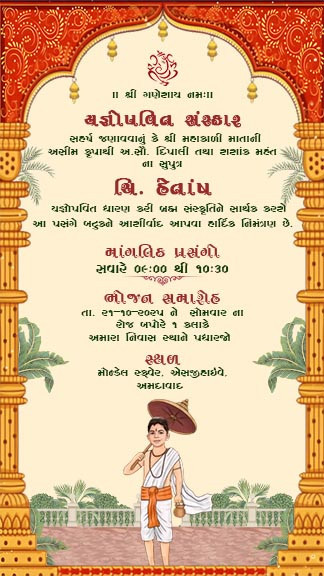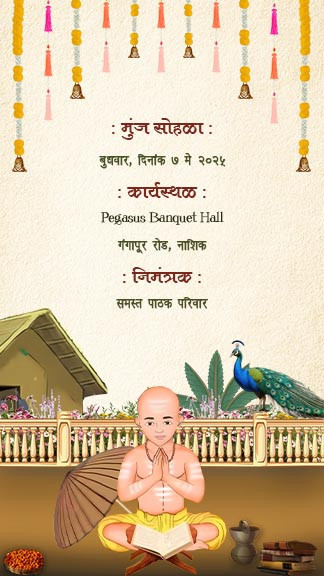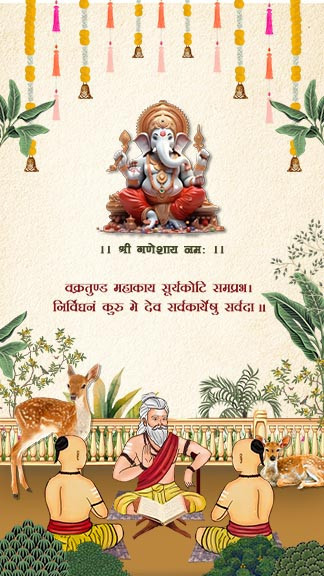views
In every Indian household, the Upanayanam or Thread Ceremony marks a sacred milestone—a boy’s transition into spiritual and educational life. As one of the most culturally rich and meaningful rituals, this ceremony calls for an invitation card that mirrors its significance. Designing the perfect Thread ceremony invitation card isn’t just about sending details—it’s about telling a story of heritage, pride, and celebration.
Here’s how you can design an invitation that beautifully blends timeless tradition with contemporary style.
1. Embrace the Essence of the Ceremony
Start by understanding what the thread ceremony represents. It’s not just a ritual—it’s an initiation into knowledge, responsibility, and spiritual learning. Reflect this meaning in your invitation with thoughtful wording, religious symbols, and a sense of reverence.
Tip: Include traditional motifs such as the sacred thread (yajnopavita), Vedic scriptures, or a young Brahmachari in traditional attire. These visuals instantly convey the sanctity of the event.

2. Choose a Color Palette That Resonates
Color sets the tone of your invitation. For thread ceremonies, earthy tones like saffron, gold, ivory, maroon, or deep blue often symbolize purity, knowledge, and tradition.
Modern twist: Use minimalistic color accents, like a gold foil on a cream base, or traditional borders with a splash of watercolor backgrounds for a softer, elegant look.
3. Craft the Perfect Wording
The wording should be a blend of tradition and warmth. Here’s a basic structure:
-
Traditional Sanskrit shloka or mantra at the top.
-
Opening line with heartfelt blessings and joy.
-
Names of the parents and the child, with details of the event.
-
Venue, date, and time in clear, legible fonts.
-
Dress code or rituals to observe, if any.
Example:
With the blessings of Lord Vishnu, we cordially invite you to the Upanayanam of our beloved son, Aarav, as he embarks on the sacred path of learning and discipline.
4. Add Personal Touches
Make it memorable with elements unique to your family or child:
-
A small note or poem from the child.
-
A family crest or a custom monogram.
-
A hand-drawn sketch or caricature of the boy in traditional attire.
These details make the card feel more intimate and special.

5. Go Digital or Traditional (or Both!)
In today’s world, you don’t have to choose between physical and digital. Opt for both!
-
Printed Cards: Ideal for elders and close relatives. Choose high-quality textured paper or eco-friendly options.
-
E-invites: Perfect for friends and long-distance guests. You can add animations, background music (like Vedic chants), or even a video invitation from the family.
Click Here: Upanayanam invitation card maker free
6. Design Inspiration: Traditional Meets Contemporary
Looking for design themes? Here are a few ideas:
-
Temple Architecture Border: South Indian gopurams or mandala designs as a frame.
-
Minimal Vedic Theme: Clean fonts, minimal illustrations, and a mantra watermark.
-
Photo Collage Design: Featuring baby-to-now pictures of the boy.
-
Scroll Invite: A traditional scroll-style card with gold tassels for a royal vibe.

7. Don’t Forget Practical Details
Make your invitation functional:
-
Include a map or QR code for the venue.
-
Add contact details for RSVP.
-
If rituals start early, mention the auspicious muhurtham time clearly.
Conclusion: Celebrate Heritage with Heart
Your thread ceremony invitation card is the first glimpse your guests will have into the celebration. It should feel like a warm hug from tradition—with a touch of modern charm. Whether you're working with a professional designer or DIY-ing it at home, focus on authenticity, emotion, and elegance.
After all, this is more than a card—it’s a keepsake of a once-in-a-lifetime milestone.






















Comments
0 comment